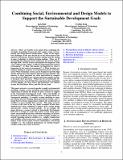Combining Social, Environmental and Design Models to Support the Sustainable Development Goals
Author(s)
Reid, Jack Burnett; Zeng, Cynthia; Wood, Danielle Renee
Download08741623.pdf (899.0Kb)
Terms of use
Metadata
Show full item recordAbstract
There are benefits to be gained from combining the strengths of modeling frameworks that capture social, environ- mental and design-based considerations. Many of the impor- tant challenges of the next decade lie at the intersection of the natural environment, human decision making and the design of space technology to inform decision making. There are 17 Sustainable Development Goals outlined by the United Nations through 2030. Several of these Sustainable Development Goals can be addressed by asking: 1) What is happening in the natural environment? 2) How will humans be impacted by what is happening in the natural environment? 3) What decisions are humans making in response to environmental factors and why? and 4) What technology system can be designed to provide high quality information that supports human decision making? The answers to these questions are often interrelated in complex ways; thus it is helpful to use a framework from complex systems to integrate these questions. Within the list of Sustainable De- velopment Goals, several fit the three questions above, including #2 Zero Hunger, #6 Clean Water and Sanitation, #13 Climate Action, #14 Life Below Water, and #15 Life on Land. This paper presents a research agenda to apply environmental modeling, complex systems modeling, and model-based systems engineering to inform the design of space systems in support of the Sustainable Development Goals. This work builds on previous research in the following areas: 1) physics-based en- vironmental modeling; 2) complex systems modeling to simu- late human decision making using agent-based models; and 3) model based systems engineering to inform the architecture of satellites or space-enabled data systems. This paper presents a review of the state of the art, shows examples of how these methods have been combined to inform space system design and presents a future research agenda. As an example, the paper discusses a project related to Sustainable Development Goal #15 to design an earth observation system using space- based and ground-based data collection regarding an invasive plant species in Benin, West Africa. In this example, insights are needed regarding natural variables (i.e. salinity, temperature and turbidity of local waterways), social variables (i.e. economic impact of the invasive plant on local communities), and design variables (i.e. the technical performance of existing imagery satellites and in-situ sensor networks).
Date issued
2019-03Department
Program in Media Arts and Sciences (Massachusetts Institute of Technology)Journal
2019 IEEE Aerospace Conference
Publisher
IEEE
Citation
Reid, Jack, Cynthis Zeng and Danielle Wood. "Combining Social, Environmental and Design Models to Support the Sustainable Development Goals." In 2019 IEEE Aerospace Conference, 2-9 March 2019.
Version: Author's final manuscript
ISBN
9781538668542